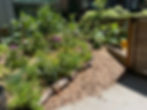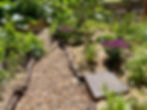Mini Food Forest Garden {Before and After}
- Alana Chau
- Jul 31, 2023
- 3 min read
Updated: Sep 24, 2024

Location: Portland, Oregon
Landscape Design: Alana Chau
Install: DIY
These clients live in a new housing development with an HOA and no backyard. Despite these constraints, the food forest we created together is incredibly abundant.

A food forest is a designed edible garden that incorporates permaculture principles and forest ecology. Although the end result is beautiful, the designing is less about aesthetics and more about output. The beauty of any such garden is enhanced by knowledge about the plants and elements
Plant Highlights:
In this garden, three dwarf fruit trees will be closely pruned every year- the Izu Persimmon a dwarf apple tree, and a standard fig tree. Using vertical space is incredibly important, with vines tucked into every nook and cranny- table grapes, kiwi and annual vines such as Carol Deppe's Sweet Meat squash. The understory consists of herbs, annual vegetables, perennial vegetables and flowering perennials.

Flowering perennials, both native to Portland as well as other favorites, bring in the pollinators. At this visit, the client explained that there weren't as many flowers as normal because she had just cut them for a bouquet. Still looks pretty abundant to me!

Perennial Kale, Scarlet Runner Beans, and various forms of Alliums are perennial staples in this understory as well.
Sustainability Highlights:
Besides the incredible habitat created for bees and butterflies, the food forest garden contains many more eco-friendly features.
The first step, as is typical, was removing the lawn. Unfortunately, the builder-grade lawn was installed with the plastic netting, so the homeowners removed as much of the dreaded plastic as was reasonable, knowing that they will be finding more as time goes on. Then, they smothered the lawn with cardboard and added material on top - wood chips for paths, compost for beds, and fallen logs from the neighborhood are used as garden edging. This allowed the new edible plants to get off to a good start. How else could the clients go from lawn to this incredible abundance in just 4 months!
In our climate, summer water is always a constraint. Yes, we get an average 36 inches of rain per year, but it all comes in winter and spring. Therefore, every design must take into consideration summer irrigation. Our strategy in this garden includes good soil (which can hold many times it's weight in water) and always keeping the ground covered (right now it's straw but will eventually include micro-clover). Drip irrigation was originally in the design, but the clients are enjoying their garden so much they have been happy to hand water while they check out their plants.

Composting is incredibly easy. Watching food scraps become soil and worms with very little effort is very satisfying. There are so many different methods of composting depending on the space and time commitment. For this home, we needed the most HOA-friendly composting system out there, so I suggested the Subpod. The results are great so far.

In a small garden such as this, we needed a self-contained water feature that could provide habitat and experimentation with food plants without taking up too much space. The half whiskey barrel is filled with aquatic plants such as wapato and water lettuce. In permaculture and food forest design, there is a strong emphasis on each element providing multiple outputs, or "stacking functions". In our case, these plants are edible, filter the water, and create habitat for frogs and dragonflies. A simple solar powered fountain keeps the water moving.

The homeowner explains: "While water lettuce are technically edible... we mainly use them as pollinator landing pads and are hoping their roots will be welcoming spawning habitat for our new Japanese rice fish." I can't wait to see the evolution of this mini-pond!
And because I can't resist a good before and after, enjoy...


Creating this garden design and supporting the family as they DIY'd it has been a real joy.